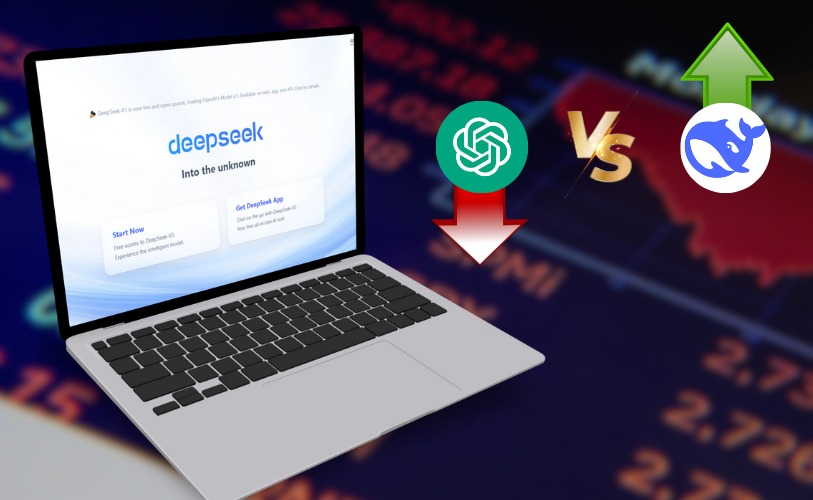
DeepSeek the AI Challenger That Disrupted the Global AI Market
In This Article
Subscribe to Our Newsletter
Introduction
The artificial intelligence landscape has been largely dominated by OpenAI, Google DeepMind, and a few other key players. However, in early 2025, DeepSeek, a relatively unknown Chinese AI company, made a shocking entry into the global market, rapidly gaining traction and shaking up the industry. In this article, we will explore DeepSeek’s launch, its impact on the stock market, its competitive stance against OpenAI, and concerns related to its availability and data privacy.
The Launch of DeepSeek and Its Rapid Market Takeover
DeepSeek was founded in 2023 by Liang Wenfeng and initially operated with limited global attention. However, its breakthrough moment came in early 2025 when it launched its free chatbot application based on the DeepSeek-R1 model for both iOS and Android on January 10, 2025.
Within just two weeks, the app became the most downloaded free app in the U.S. iOS App Store, surpassing ChatGPT. This rapid adoption triggered major reactions across the AI and technology sectors. As investors and tech analysts scrambled to evaluate the impact of DeepSeek’s growth, Nvidia’s stock price plummeted by 18%, contributing to a $1 trillion decline in American stock values. This unprecedented market reaction signified how seriously DeepSeek’s entry was perceived by industry giants.
(Source: TechCrunch, CNBC)
DeepSeek vs. OpenAI: Key Comparisons
DeepSeek’s rise to prominence naturally invites comparisons with OpenAI. Here’s how the two AI powerhouses stack up against each other across different metrics:
1. AI Models and Performance
DeepSeek’s flagship model, DeepSeek-R1, competes directly with OpenAI’s latest models. A key differentiator is DeepSeek’s use of the “mixture of experts” technique, where only the necessary computing resources are activated per task, improving efficiency and reducing costs.
-
DeepSeek-R1 is comparable to OpenAI’s GPT-4 in reasoning tasks, particularly excelling in chain-of-thought reasoning.
-
However, DeepSeek-R1 performs slightly worse than OpenAI’s models in specific problem-solving scenarios.
-
Unlike OpenAI, DeepSeek has made its model weights open-source, making it accessible and customizable for developers worldwide.
(Source: Arxiv, MIT Technology Review)
2. Cost and Training
One of the most surprising aspects of DeepSeek’s success is its low-cost development model.
-
DeepSeek reportedly trained its R1 model with a budget of $5.58 million, a fraction of the estimated hundreds of millions spent by OpenAI for its models.
-
OpenAI’s GPT models require vast computational power and proprietary infrastructure, making them more costly to operate compared to DeepSeek’s leaner architecture.
(Source: Forbes, Financial Times)
3. Availability Across Countries
While OpenAI’s ChatGPT is available in many countries, its services are restricted or unavailable in some regions due to regulatory concerns. DeepSeek, despite being a Chinese company, managed to penetrate the global market effectively.
-
As of January 2025, DeepSeek’s chatbot app was widely available in the United States, quickly surpassing ChatGPT in user downloads.
-
However, it is unclear how freely DeepSeek operates in regions like Europe, where data privacy regulations are stricter.
(Source: Reuters)
4. Data Privacy and Censorship Concerns
Data privacy remains a significant point of discussion when comparing these two AI giants.
-
DeepSeek has faced concerns about potential government influence, as it reportedly aligns with Chinese regulations and avoids politically sensitive topics.
-
OpenAI, on the other hand, follows a more Western-centric ethical alignment, ensuring its models do not engage in biased outputs but maintaining some level of content moderation.
-
OpenAI’s proprietary nature means user interactions are stored for model improvement, whereas DeepSeek’s open-source approach raises questions about how it manages and secures user data.
The Future of DeepSeek and AI Competition
DeepSeek’s meteoric rise demonstrates how rapidly the AI industry can shift. If it continues to innovate and refine its models while maintaining a competitive pricing strategy, it could establish itself as a dominant force in AI. However, challenges remain, particularly in addressing:
-
Regulatory scrutiny, particularly in Western markets.
-
Ethical concerns regarding censorship and bias.
-
Competition from OpenAI, Google, and other AI developers improving their models.
(Source: Bloomberg)
Conclusion
DeepSeek’s launch and subsequent market disruption mark one of the biggest AI industry shifts in recent years. By leveraging cost-effective AI training methods and open-source principles, it has positioned itself as a serious competitor to OpenAI. However, concerns around data privacy and regulatory challenges may shape how sustainable its growth will be in the long run. Whether DeepSeek remains a global AI leader or fades due to geopolitical and regulatory pressures remains to be seen, but its impact on the AI landscape is undeniable.
(Source: BBC, New York Times)